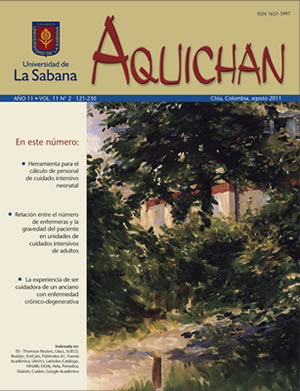Surgery: Between Both Anguish and Joy
Keywords:
Patient, nursing care, cualitative research, emotionsAbstract
Objective: To describe the categories constituting part of the factors responsible for a theoretical framework that emerged during the study: living with ambivalence in the interactions surrounding care. Method: A qualitative method with an approach grounded in theory was used, along with techniques such as observation and formal and informal interviews with 20 patients and 19 nursing assistants and nurses who work at eight different second-tier surgical centers in the Aburrá Valley (Colombia). Results: The categories related to the feelings and emotions of the patient and the nursing staff upon admission to a surgical center are presented as part of the causal factors. Patients want normality, because they are experiencing both physical and emotional discomfort, but also have feelings of ambivalence about the surgical procedure. The nursing team is disposed to providing care, because nurses identify themselves as working for and with human beings and being responsible for the patient’s care during this period. Conclusions: The nursing team in a surgical facility must be aware of the importance of the emotional, social and human dimensions of care, giving special attention to the fear and anxiety to which patients are exposed. Therefore, in terms of humane care in this scenario, it is vital to see the other person as the object of care and attention in his or her context, with their beliefs and values, and accepting that context for what it is.Downloads
Download data is not yet available.
Published
2011-08-29
How to Cite
Salazar-Maya, Ángela M. (2011). Surgery: Between Both Anguish and Joy. Aquichan, 11(2), 187–198. Retrieved from https://aquichan.unisabana.edu.co/index.php/aquichan/article/view/1900
Issue
Section
Articles
License
1. Proposed Policy for Journals That Offer Open Access
Authors who publish with this journal agree to the following terms:
- The journal and its papers are published with the Creative Commons License Attribution-NonCommercial-NoDerivatives 4.0 International (CC BY-NC-ND 4.0). You are free to share copy and redistribute the material in any medium or format if you: give appropriate credit, provide a link to the license, and indicate if changes were made; don’t use our material for commercial purposes; don’t remix, transform, or build upon the material.





